
Looking for How to can your own homemade canned peas (English, crowder, purple hull, blackeye) in 2025? Scroll down this page and follow the links. And if you bring home some fruit or vegetables and want to can, freeze, make jam, salsa or pickles, see this page for simple, reliable, illustrated canning, freezing or preserving directions. There are plenty of other related resources, click on the resources dropdown above. If you are having a hard time finding canning lids, I've used these, and they're a great price & ship in 2 days.
If you have questions or feedback, please let me know! There are affiliate links on this page. Read our disclosure policy to learn more.
How to can your own homemade canned peas (English, crowder, purple hull, blackeye)
How to Make Homemade Canned Peas (English Peas, Purple Hull Peas, Crowder Peas, Blackeyed Peas, Etc.)
 You
think making and canning your own peas is difficult or expensive? Not at
all! The only trick is, you really do need a Pressure Canner. Every
university food science department and the government will tell you that it just
is not safe to use the water bath bath method; it takes the higher temperatures
of the pressure canner to kill the botulism bacteria.
You
think making and canning your own peas is difficult or expensive? Not at
all! The only trick is, you really do need a Pressure Canner. Every
university food science department and the government will tell you that it just
is not safe to use the water bath bath method; it takes the higher temperatures
of the pressure canner to kill the botulism bacteria.
See this FAQ for details: Can I use a water-bath canner instead of a Pressure Canner for low acid foods like peas?
BUT, with a Pressure Canner it's easy. And although a Pressure Canner costs $100 to $200 (see this page for pressure canners models, makes and prices), they last a lifetime, and your children and grandchildren may be using it. You can also find free information from the USDA in this PDF file (it will take a while to load!) about selecting and using canners here!
So, here's how to can peas, English peas, crowder peas, blackeye peas, purple hull peas! After this, I'll just refer to the peas as "peas". but the same instructions works for the other types of peas. The directions are complete with instructions in easy steps and completely illustrated. In the winter when you open a jar, the peas will taste MUCH better than any store-bought canned peas (although I think frozen peas will taste ten times better than canned). Note: It is recommended that snow peas, mange tout, sugar snap and Chinese edible pods be frozen, rather than canned, for best quality.
Prepared this way, the jars have a shelf life of about 12 months, and aside from storing in a cool, dark place, require no special attention. If you'd rather freeze your fruit, see my page on how to freeze beans (it works for peas) Even easier than canning and they will taste just like fresh.. but it does take up space in the freezer.
Directions for Making Canned Peas
Ingredients
-
Peas (see step 1)
Equipment
- Jar grabber (to pick up the hot jars)
- Jar funnel ($4 at mall kitchen stores and local "big box" stores, but it's usually cheaper online from our affiliates)
- At least 1 large pot
- Large spoons and ladles,
- Canning jars (often called Ball jars, Mason jars or Kerr jars) (Publix, Kroger, other grocery stores and some "big box" stores carry them - now about $12 per dozen quart jars (up 50% in 2 years!) including the lids and rings)
- Salt (optional - I don't use any)
- 1 Pressure Canner (a large pressure pot with a lifting rack to sanitize the jars after filling (about $75 to $200 at mall kitchen stores and "big box" stores, but it is cheaper online; see this page for more information). For low acid foods (most vegetables, you can't use an open water bath canner, it has to be a pressure canner to get the high temperatures to kill the bacteria. If you plan on canning every year, they're worth the investment.
Recipe and Directions
Step 1 - Selecting the peas
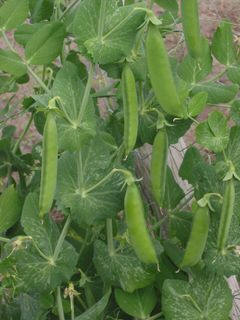 The
most important step! You need peas that are FRESH and crisp.
Limp, old peas will make nasty tasting canned peas. Guests will
probably throw them at you.. Select filled but tender, firm, crisp peas.
Remove and discard any soft, diseased, spotted and rusty pods.
The
most important step! You need peas that are FRESH and crisp.
Limp, old peas will make nasty tasting canned peas. Guests will
probably throw them at you.. Select filled but tender, firm, crisp peas.
Remove and discard any soft, diseased, spotted and rusty pods.
Peas are of the best quality when they are fully expanded but immature, before they become hard and starchy. Peas should be picked immediately before cooking because their quality, especially sweetness (like that of sweet corn), deteriorates rapidly. FYI, the pods on the lower portion of the plant mature earliest.
How many peas and where to get them
You can grow your own, pick your own, or buy them at the grocery store. About 14 pounds of peas makes 7 quart jars; or 9 pounds is needed per 9 pints. A bushel, which produces anywhere from 13 to 20 quarts, weighs 30 pounds. That works out to an average of 2 pounds of peas per finished quart jar.
Step 2 - Prepare the jars and pressure canner
 Wash the jars and lids
Wash the jars and lids
This is a good time to get the jars ready! The dishwasher is fine for the jars; especially if it has a "sanitize" cycle. Otherwise put the jars in boiling water for 10 minutes. I just put the lids in a small pot of almost boiling water for 5 minutes, and use the magnetic "lid lifter wand" (available from target, other big box stores, and often grocery stores; and available online - see this page) to pull them out.
Get a large pot of water boiling
We will use this water to pour over the peas and fill each jar with liquid, after we've packed them full of peas. I use the largest pot I have, so that there is plenty of clean, boiling water ready when I need it.
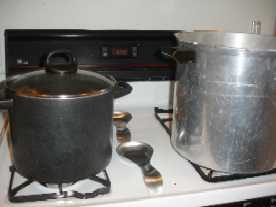
Get the pressure canner heating up
Rinse out your pressure canner, put the rack plate in the bottom, and fill it to a depth of 4 inches with hot tap water. (of course, follow the instruction that came with the canner, if they are different). Put it on the stove over low heat, with the lid OFF of it, just to get it heating up for later on.
Step 3 -Hull the peas
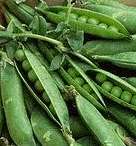
 I
find it easiest to just grab the stem end, and press my thumbnail into the seam,
squeezing the pod gently. It usually opens right up, and I can use a
finger to push the peas out.
I
find it easiest to just grab the stem end, and press my thumbnail into the seam,
squeezing the pod gently. It usually opens right up, and I can use a
finger to push the peas out.
Step 5 - Packing the peas in the canning jars
This is called "raw packing" (compared with "hot packing")because we don't cook the peas before packing them into the jars. Pack the jars fairly tightly, but be sure to leave 1 inch of space at the TOP of the jar. That is called "headspace" and is needed for expansion during heading.
Note: Revised photos are coming (the peas didn't suddenly become beans - the photos didn't turn out clear!) But it works just the same way.
Step 6 - Pour boiling water into each packed jar
 Use a ladle or pyrex measuring cup to carefully fill each packed jar
with water from pot of boiling water. Fill to within 1 inch of the top.
The peas should be covered and there should still be 1 inch of airspace
left in the top of each jar. Be careful not to burn yourself, (or anyone
else - children should be kept back during this step!)
Use a ladle or pyrex measuring cup to carefully fill each packed jar
with water from pot of boiling water. Fill to within 1 inch of the top.
The peas should be covered and there should still be 1 inch of airspace
left in the top of each jar. Be careful not to burn yourself, (or anyone
else - children should be kept back during this step!)
Step 7 - Put the lids and rings on
Put the lids on each jar and seal them by putting a ring on and
screwing it down snugly (but not with all your might, just "snug").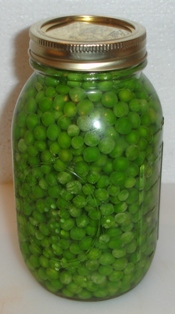
Step 8 - Put the jars in the canner and the lid on the canner (but still vented)
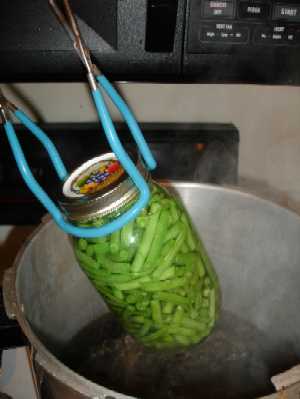 Using
the jar tongs, put the jars on the rack in the canner. By now the
water level has probably boiled down to 3 inches. If it is lower
than that, add more hot tap water to the canner. When all the jars that
the canner will hold are in, out on the lid and twist it into place, but
leave the weight off (or valve open, if you have that type of pressure
canner).
Using
the jar tongs, put the jars on the rack in the canner. By now the
water level has probably boiled down to 3 inches. If it is lower
than that, add more hot tap water to the canner. When all the jars that
the canner will hold are in, out on the lid and twist it into place, but
leave the weight off (or valve open, if you have that type of pressure
canner).
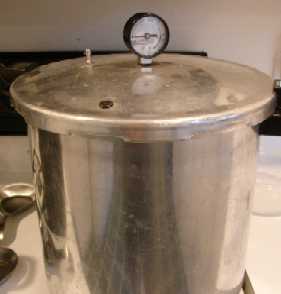 Step
9 - Let the canner vent steam for 10 minutes
Step
9 - Let the canner vent steam for 10 minutes
Put the heat on high and let the steam escape through the vent for 10 minutes to purge the airspace inside the canner.
Step 10 - Put the weight on and let the pressure build
After 10 minutes of venting, put the weight on and close any openings
to allow the pressure to build to 11 pounds.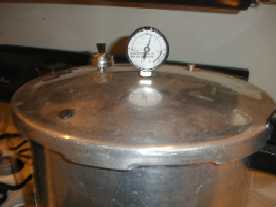
Step 11 - Process for 30 minutes
Once the gauge hits 10 pounds, start your timer going - for the time in the chart below, depending upon the size of the jar, and if you are at high altitude, adjust for that. Adjust the heat, as needed, to maintain 10 pounds of pressure.
Note: the chart below will help you determine the right processing time and pressure, if you have a different type of canner, or are above sea level.
It is important to learn how to operate your pressure canner by reading the owner's manual that came with your particular canner. If you cannot find your owner's manual, you can obtain find one online: Here is where to find some common manufacturer's manuals:
or by contacting the company that made your canner. Give the model number to the manufacturer, and they will send you the right manual. Click here for more information about pressure canners and a variety of models you can order.
|
Recommended process time for peas in a weighted-gauge pressure canner. |
|||
| Canner Pressure (PSI) at Altitudes: | |||
| Jar Size | Process Time | 0 - 1,000 ft | Above 1,000 ft |
| Pints | 30 min | 10 lb | 15 lb |
| Quarts | 40 | 10 | 15 |
|
Recommended process time for Peas in a dial-gauge pressure canner. |
|||||
| Canner Pressure (PSI) at Various Altitudes | |||||
| Jar Size | Process Time | 0 - 2,000 ft | 2,001 - 4,000 ft | 4,001 - 6,000 ft | 6,001 - 8,000 ft |
| Pints | 30 min | 11 lb | 12 lb | 13 lb | 14 lb |
| Quarts | 40 | 11 | 12 | 13 | 14 |
Step 12 - Turn off the heat and let it cool down
 When the processing time from the chart above is up, turn off the
heat, and allow the pressure canner to cool and the pressure to drop to
zero before opening the canner. Let the jars cool without being jostled.
After the pressure drops to zero (usually, you can tell but the "click"
sound of the safety release vents opening, as well as but the gauge. Let
the pressure in the canner drop to zero by itself. This may take 45
minutes in a 16-quart canner filled with jars and almost an hour in a
22-quart canner. If the vent is opened before the pressure drops to zero
OR if the cooling is rushed by running cold water over the canner,
liquid will be lost from the jars. Too rapid cooling causes loss of
liquid in the jars!
When the processing time from the chart above is up, turn off the
heat, and allow the pressure canner to cool and the pressure to drop to
zero before opening the canner. Let the jars cool without being jostled.
After the pressure drops to zero (usually, you can tell but the "click"
sound of the safety release vents opening, as well as but the gauge. Let
the pressure in the canner drop to zero by itself. This may take 45
minutes in a 16-quart canner filled with jars and almost an hour in a
22-quart canner. If the vent is opened before the pressure drops to zero
OR if the cooling is rushed by running cold water over the canner,
liquid will be lost from the jars. Too rapid cooling causes loss of
liquid in the jars!
Step 13 - Remove the jars
Lift the jars out of the water and let them cool on a wooden cutting board or a towel, without touching or bumping them in a draft-free place (usually takes overnight), here they won't be bumped. You can then remove the rings if you like, but if you leave them on, at least loosen them quite a bit, so they don't rust in place due to trapped moisture. Once the jars are cool, you can check that they are sealed verifying that the lid has been sucked down. Just press in the center, gently, with your finger. If it pops up and down (often making a popping sound), it is not sealed. If you put the jar in the refrigerator right away, you can still use it. Some people replace the lid and reprocess the jar, then that's a bit iffy. If you heat the contents back up, re-jar them (with a new lid) and the full time in the canner, it's usually ok. You're done!
Other Equipment:
 From
left to right:
From
left to right:
- Jar lifting tongs
helpful to pick up hot jars - Lid lifter
- to remove lids from the pot
of hot water - Lids
- disposable - you may only
use them once - Ring
- holds the lids on the jar until after
the jars cool - then you remove them, save them and reuse them - Canning Jar funnel
- to fill the jars
Frequently Asked Questions
Q. Canning using frozen peas? Hello, I am new to canning. I have 3 gallon bags of frozen black-eyed peas that I need to get out of my freezer. They were given to me and are frozen in one large package. Can I cook these and then can them? It will be more than we can eat. I have searched online and in my books but I can't find any recommendations for canning frozen food. Thanks -kathy
Yes, you may can from frozen produce, although there may be some additional loss in quality. Whether that will be enough to notice is hard to say, most likely not, with black eyed peas. But don't "cook them" and then can them, simply bring them to room temperature, then can them according to canning directions for fresh peas: https://www.pickyourown.org/peas_canning.htm
Q. Is it safe to can peas in a traditional water bath? If so how long do you do process them?
A. The answer, quite simply is no. Quoting from the Ohio State University Extension's Fact Sheet:
"Pressure canning is the only safe method for home canning vegetables. Clostridium botulinum is the bacterium that causes botulism food poisoning in low-acid foods, such as vegetables. The bacterial spores are destroyed only when the vegetables are processed in a Pressure Canner at 240 degrees Fahrenheit (F) for the correct amount of time.Clostridium botulinum is the bacterium commonly found in vegetables and meats. It is harmless until it finds itself in a moist, low-acid, oxygen-free environment or a partial vacuum. Under these conditions, the bacterium can grow and produce toxins dangerous to people and animals.
Do not process (low acid) vegetables using the boiling water bath because the botulinum bacteria can survive that method.
Can fruits and vegetables be canned without heating if aspirin is used? No. Aspirin should not be used in canning. It cannot be relied on to prevent spoilage or to give satisfactory products. Adequate heat treatment is the only safe procedure.Is it safe to can peas in a boiling water bath if vinegar is used? No. Recommended processing methods must be used to assure safety. Recommended processing times cannot be shortened if vinegar is used in canning fresh vegetables. (This does not refer to pickled vegetables.)
Salt and sugar are not preservatives for vegetables: they are added to stabilize and improve flavor, but will not prevent spoilage.
Salicylic acid is also NOT a preservative. The University of Illinois reports:
Using Aspirin for Canning
Several years ago, a recipe circulated using aspirin to acidify tomatoes and peas for canning. Aspirin is not recommended for canning. While it contains salicylic acid, it does not sufficiently acidify tomatoes or peas for safe hot water bath canning. Green peas are low acid foods and may only be processed safely in a Pressure Canner. Lemon juice or vinegar is recommended to acidify tomato products for safe water bath processing.
Think of it like smoking. We all know someone who smoke their entire life and lived to be 90. But the cemeteries are filled with the vast majority who didn't. You will hear people say "my grandmother did it that way for 20 years". But of course, the people who died from food poisoning aren't around and often didn't have descendants to tell their tale...
Looking for canning equipment and supplies?
Water bath canner with a jar rack
Pressure canners for gas, electric and induction stoves: Presto 23Qt or T-fal 22Qt
Canning scoop (this one is PERFECT)
Ball Blue book (most recent version)
Jars: 8oz canning jars for jams
Find Other types of farms:
Farm markets and roadside stands
Road trips and camping resources
Local Honey, apiaries, beekeepers
Consumer fraud and scams information
Home canning supplies at the best prices on the internet!
Maple Syrup Farms, sugarworks, maple syrup festivals
Environmental information and resources
Farms For Your Event for birthday parties, weddings, receptions, business meetings, retreats, etc.
Festivals - local fruit and vegetable festivals
Get the
most recent version of
the Ball Blue Book
With this Presto 23 quart pressure canner and pressure cooker, you can "can" everything, fruits, vegetables, jams, jellies, salsa, applesauce, pickles, even meats, soups, stews. Model 01781

You can make jams, jellies, can fruit, applesauce, salsa and pickles with water bath canners, like this Granite Ware 12-Piece Canner Kit, Jar Rack, Blancher, Colander and 5 piece Canning Tool Set

